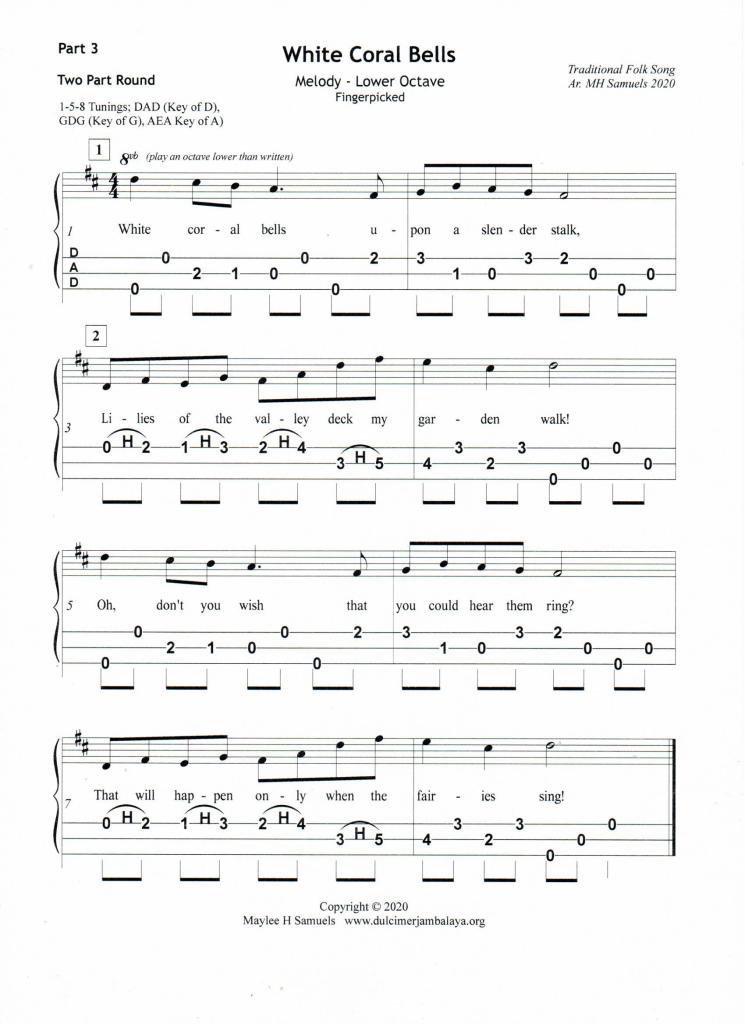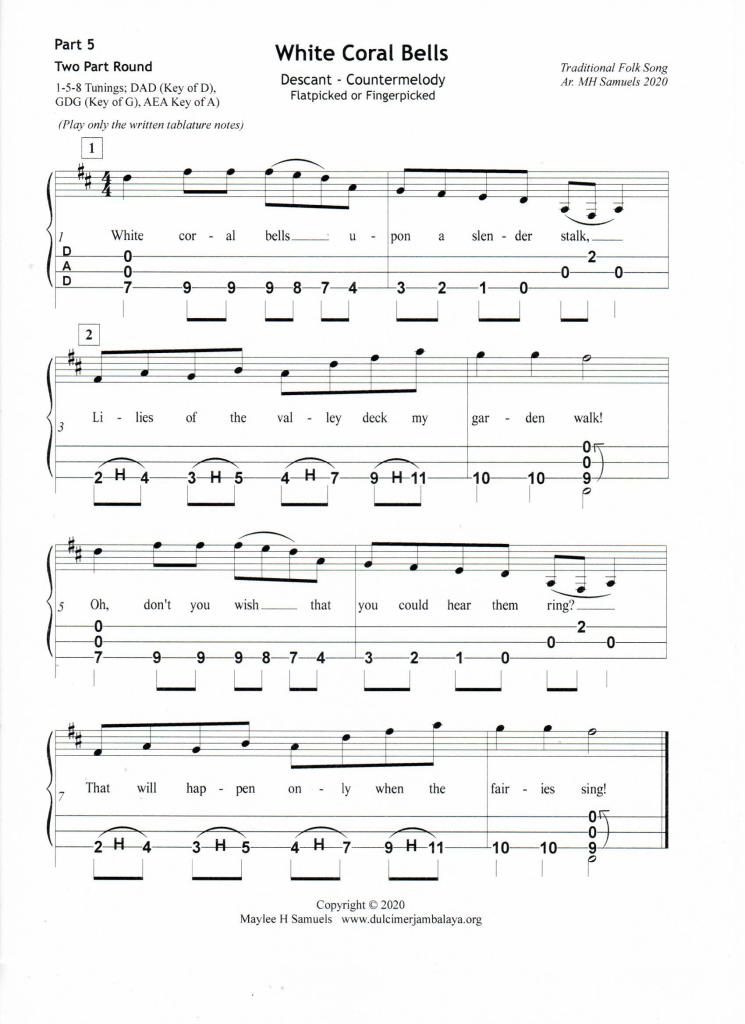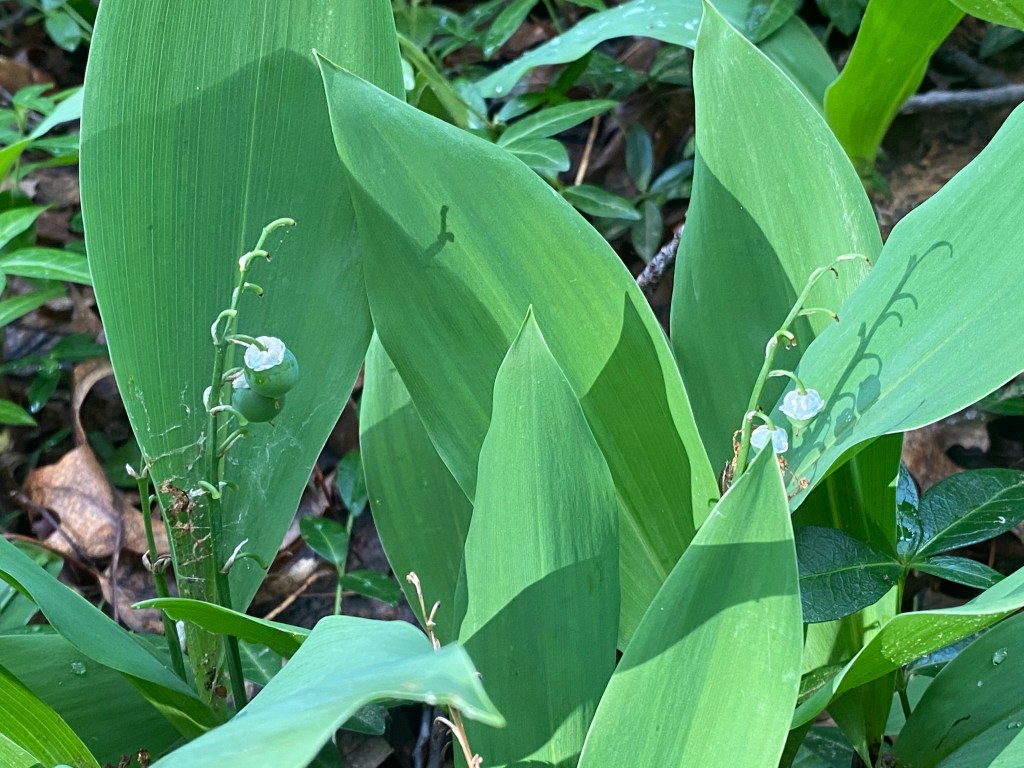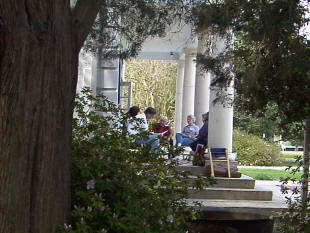While on a recent shopping trip, I saw a young man wearing a T-shirt which said, “Without Music, Life would Bb.” How true, yes, life would be flat without music. Music lifts the spirit, makes us come alive. We communicate through music and create through music. Whenever I’m a little down, playing the dulcimer gets me going again and is a sure “pick me up” activity. My anxiety goes away. “White Coral Bells” is a song which truly lifts the spirit. While you wouldn’t think of this tune as a “mountain dulcimer” song in the traditional sense, I’ve made an arrangement which works well on the mountain dulcimer. I got a little carried away and came up with several parts: a version for strumming, fingerpicking and flatpicking as well as parts for an higher octave and harmony, descant-countermelody and rhythm. It’s a round and all the parts go together. As you play the round back and forth, the song and melody seem to sway. This is a great tune to lift up the spirit! So gather up several dulcimer players and enjoy endless ways to play this tune.

Here are Lilies of the Valley with their white coral bells growing by my brother’s home in Boston. He kindly obliged and took these photos for me. Yes, the plant does exist especially in northern parts of our country. In fact, this song may have originated in Ithaca, New York, where these flowers grow. Lilies of the Valley are also known as May Bells, Our Lady’s Tears, and Mary’s Tears.
Singing as a Musical Activity
I remember “White Coral Bells” from my childhood as one we sang in summer Girl Scout camps and also summer church camps. But more than those memories, my mother loved to sing this song and taught it to us when we were young. It’s a folk song and its origin is unclear. Since my mother sang it to us, it is probable that she also sang it in her younger years, too. It has always been a family favorite and continues to be so.
And it is interesting that even as my mother’s Alzheimer’s disease advanced, she could still sing all the old hymns and songs and recall the words. Although she didn’t know the day of the week or recent events, she could still sing. When I came for visits, she was very content when I would get out my dulcimer; play and sing for her on the porch at the Retirement Center. At the end of the post is a photo of both my daughter and myself playing for her.

Certain activities remain preserved in dementia and are very resistant to decline. These include pedaling an indoor bicycle, enjoying music, dancing and throwing a baseball. These activities are learned and ingrained in a person’s younger years and remain as dementia advances. The memory for these activities is called Procedural Memory (PM). Memory for events, knowledge, and reasoning, known as Explicit Memory (EM), gradually disappears as dementia worsens.
Not only does singing help us from an emotional point of view, it is important for socialization and also memory. Yes, life would be flat without music and singing.
It’s the Genes
All my family ancestors were musical — they liked to sing. One great-uncle Blough sold musical instruments to high school players in Iowa in the early 1900’s just like in the “Music Man” musical. My maternal grandfather was a tenor in his college’s glee club in the 1910’s and I inherited his songbook, “Quartets and Choruses for Men,” published in 1913 for $0.50. My uncle recounts that this Iowa grandfather liked to sing hymns on his way to the farm fields for the day’s work. I’m sure farm life was hard work in the 1930’s and singing must have made it easier. Singing children’s tunes was one of my maternal grandmother’s favorite activities when we went for visits to Iowa when we were young. We sang songs such as “The Dish Washing Song” to get us motivated. On my father’s side, my grandfather was a pastor. In his Ohio congregation, he sang duets with my grandmother in church with my grandmother on piano.

It takes Practice
So I see where my musical genes comes from! However, other than several years of piano lessons as a child and church choir, I didn’t pursue singing or playing musical instruments as an adult. By chance, I happened upon the mountain dulcimer while on vacation and purchased it. Genes aren’t automatic. It takes practice and and at first I had no clue how to play this instrument. Over the years, I’ve gradually learned to play the dulcimer and have become much more proficient at playing and arranging tunes for the dulcimer. I believe that most folks have musical genes — I am always amazed at how most of my adult dulcimer students have succeeded at learning to play the dulcimer. It takes practice to learn any new skill. And taking the time to practice the dulcimer will reward you with hours of beautiful music and satisfaction. Here’s our “Thursday Group,” the “Red Stick Strummers,” at a nursing home performance.

“White Coral Bells” History
According to the Traditional Ballad Index, (The Traditional Ballad Index is copyright © 2020 by Robert B. Waltz and David G. Engle), the earliest known reference to “White Coral Bells” is 1916. It was known as “May Bells” and published, without an author, in the “Fourth Year” volume of “Hollis Dann Music Course.”
Hollis Ellsworth Dann (1861 – 1939) was an American music educator and choral director. His career was prolific. In 1887, Dann was hired to teach penmanship in the public schools in Ithaca, New York, with a promise of teaching music education which did not exist in public schools at that time. Later, he founded the Ithaca Conservatory of Music in 1892 (now Ithaca College). Dann was instrumental in beginning the music department at Cornell University. He led summer school at Cornell for teachers and supervisors of music, training hundreds of music teachers. Dann wrote numerous music education books throughout his career including the eight-volume Hollis Dann Music Course and the five-volume Hollis Dann Song Series. He compiled the first Army Song Book.
Was it is possible that “White Coral Bells” was disseminated through Dann’s music education books across the country? Now, the tune is a standard Girl Scout summer camp song and has been sung around the country by hundreds of girls over the years.
“White Coral Bells” Arranged for Mountain Dulcimer
The tune, “White Coral Bells” is a beautiful, melodic two-part round. The tune is very short; it is only 4 measures long and then repeats. But the harmonies, when played as a round, are striking and the song seems to lift you up. At summer camps, we sang the song “acapella” unaccompanied by any musical instruments.
To arrange this tune for the dulcimer, it took some innovation. At first glance, this isn’t the best “fitted” song for playing on the mountain dulcimer. Since the song so melodic, “drones” or open strums on the middle and bass strings distract from the tune and “muddle” the playing. Plus, there is a wide range on notes in the melody. In DAD tuning, these notes revolve around the “7” fret and higher — not the easiest tune to play.
I was able to find a very pleasing arrangement by noting the tune an octave lower on the dulcimer fretboard than the top staff notes. In addition, my arrangement includes playing only the melody notes plus just a few harmony notes. In general in this tune, keep the drones out of one’s playing and stick to the tablature notes. In the basic part (Part 1), the song starts on the middle string, third fret, goes to the bass string and then back to the middle string. None of the song’s melody is played on the melody string. Yes, this is not a traditional “fiddle” dulcimer tune.

I arranged parts for flatpicking, strumming, and fingerpicking (Parts 1, 2 and 3). It is easiest to see the melody on the flatpicked version (Part 1). All these parts are basically the same, with a few variations for fingerpicking and strumming. For a traditional dulcimer part, I noted the song an octave higher on the melody string (Part 4).
Additional new tune parts. In addition, I got carried away and created a descant-countermelody part (Part 5), a harmony part (Part 6) and a rhythm part (Part 7). These are new tune parts to the song and add more variation. They are “stand alone” parts and may be played as a solos. Since the basic tune is only 4 measures long, it is very repetitive. The descant-countermelody and harmony parts can be played along with the basic tune or as a “break” which lengthens the song, provides a “surprise” and a little more variation to the tune. The “rhythm part” (Part 7) is just for fun and adds contrast. Try it and see if you like it.
Hammer-On’s. This is a good tune to practice hammer-on’s. In measure #3, the melody “runs” up the scale and it is much easier to play if you “hammer-on” the string at the frets to play the tune.
Playing the Tune as a Round
“White Coral Bells” is a two-part round. The second part always begins on measure #3 — regardless of what part you are playing. When it is a played as a round, the song seems to sway back and forth between the two parts and singers (or dulcimer players). It is a truly beautiful and uplifting song.
In my arrangement, all the parts go together, so mix and match. (Parts 1, 2 and 3 are essentially the same tune for different styles of dulcimer players.) Play the basic tune as a round; or play the basic tune along with the harmony, descant-countermelody and rhythm parts. Play each part individually and one at a time. Play all the parts together as a very extended round. The second dulcimer player(s) always come in on measure #3 in the round regardless of what part is being added. There are endless possibilities here.
1-5-8 tuning and playing/singing in other keys
This song’s tablature is in the Key of D and DAD tuning. For singing, it is probably easier to sing in other keys such as the Keys of C, G or A because of the wide range of notes in the song. So, this is a great song to get out the ginger dulcimers and baritone dulcimers. Since the tablature is in 1-5-8 tuning, the song can easily be played with dulcimers tuned to other keys — thus changing keys to G or A. For a ginger or baritone dulcimer tuned to GDG, this is the Key of G. For a baritone dulcimer in AEA tuning, this is the Key of A. To get to the Key of C, just lower the strings of a DAD tuned dulcimer one full pitch to CGC. If you are changing to one of these tunings, just remember to transpose the melody notes on the top staff in your head to match the dulcimer’s key.
Here are images of the tune. I included a PDF file containing all the parts which you can download and play. In our world of turmoil and strife, enjoy music.
Yes, Life would be flat without music. Please play and share this uplifting song with others! Play it on the dulcimer and sing it to your children and grandchildren and to your elderly family members. Enjoy!









Reference:



What a terrific blog post! I love this song and had no idea it might have an Ithaca connection. My dad’s side of the family have lived in the Ithaca area for generations — and might have crossed paths with Mr. Dann at public school or Ithaca College or Cornell! I live in the Boston area and love Lilies of the Valley. We used to have a bunch of them by our garage – but they all got dug out (sadly) when a new driveway was installed. ps: I found your blog post by entering “music” into the search field of my WordPress reader…
LikeLike
Thanks for visiting my blog! And I am glad you enjoyed the post. This has been a creative outlet for me to share songs, stories, music and information about playing the mountain dulcimer as well as our activities here in Louisiana. There are so many ways to play the dulcimer — it is a rewarding musical instrument. Yes, I was interested to learn that this song, “White Coral Bells” probably originated in the Ithaca area as we have traveled to that part of New York many times with my daughter attending Eastman School of Music and if your family was involved in music, perhaps they knew the very prolific Mr. Dann. FYI, my daughter has relocated to Boston for graduate school, so if you ever need an upright bass play for gigs, I know an available musician! And I love all the connections I have made via WordPress!
LikeLike
I, too, have fond memories of this song. Its very old. My English grandmother sang it to me in the mid 1940’s. She had learned it from her mother, which would have been probably the late 1890’s. The words wore slightly different. “White coral bells, upon a midnight bright, lily of the valley in the garden white. The rest was the same.
LikeLiked by 1 person
Hello Ed, I’m so glad you shared your story. What a treat! This was my mother’s favorite song — we even sang it at her funeral. Glad to know someone else has good memories of the song, too. Thanks for visiting my blog!
LikeLike
My kids and now my grandkids also love it. My name is not Ed. It is Edi, which probably doesn’t matter anyway.
LikeLiked by 1 person
Hello, sorry about the typo. Thanks for the correction. A memorable tune for our family, too!
LikeLike
We sang white Coral Bells at the St. Paul, MN Camp Fire Girls Camps (Lokinda. Cheewin, and Ojiketa in the 1930’s to the 1980’s. I am not sure if they continued singing them until the last of the camps e part of Montana’s highway systemclosed in 2006. My mother was also a Camp Fire Girl, in Montana at Camp Cheskamey (which long ago became part of Montana’s highway system.
LikeLiked by 1 person
Yes, this was a great camp song. Those Minnesota camps had interesting Indian names! Thanks for visiting my blog.
LikeLike